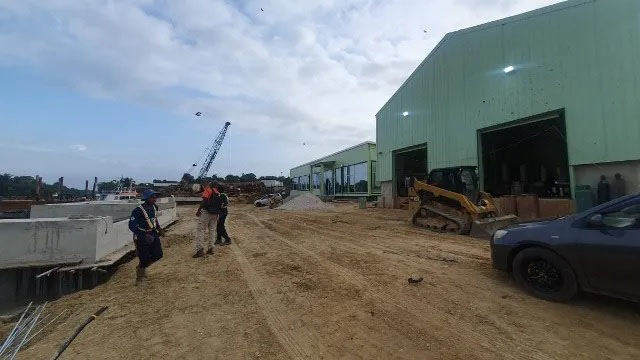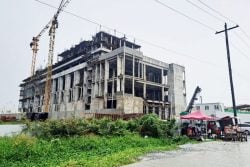-new design completed
The contractor for the $1.4b Port Kaituma stelling yesterday said that serious flaws that have arisen in the structure were due to the poor design for the project.
In a release yesterday, the company, International Import and Supplies, located at Lot 15 Garnett Street, and owned by Parmeshwar Jagmohan, stated that its aim is to address recent misinformation circulating about the Port Kaituma Stelling construction project and in so doing, correct any inaccuracies and protect the company’s reputation.
According to the statement, International Import and Supplies was awarded the contract to construct the north west Stelling on December 30, 2022, through a process of public tender. The contractor’s scope was limited to the construction of the physical structure, while the design and project supervision were undertaken separately by a local consultancy firm.
It went on to assert that materials procurement and construction were conducted in strict accordance with the project specifications and Bill of Quantities, with critical elements sourced from pre-approved suppliers in Europe and China. As of February 18 this year, the project was on schedule and approximately 90 per cent completed. During the final stages of casting pile caps, fissures were observed within the backfilled area, prompting an immediate cessation of work and notification to the consultant and the Ministry of Public Works. Initial investigations indicated that the tie rod strength specified in the design was inadequate.
At this point, an independent third-party firm was engaged to review the initial design, revealing additional deficiencies in the design, particularly in the affected zone of the structure. The Ministry retained this firm to conduct a new geotechnical survey and prepare a revised design.
The new independent design has been completed, addressing the deficiencies identified in the initial design, which includes the implementation of longer and thicker piles and tie rods. These items, the release disclosed, have already been procured, and preparations are underway to resume work on the project.
However, International Import and Supplies holds firm to the view that there was a malicious attempt to besmirch the reputation of the company and its proprietor.
The company asserted that it is committed to delivering quality projects and will continue to operate with a high level of transparency, while assuring that it remains a committed partner in development with the Government of Guyana, and will ensure that value for money is provided and that a quality stelling will be delivered to benefit the citizens, as intended.
The company also maintained that the initial failure of the revetment was due to a design flaw beyond the company’s control, as pointed out by the independent third-party review, adding that International Import and Supplies has a proven track record of completing 100 per cent of their contracts and addressing any defects during and after the liability period.
“The company apologizes for any inconvenience caused and assures the public of its dedication to excellence.”
Anyone needing further information on the project, can contact the company’s project engineer, Maheshwar Ragoobeer, at +592-608-9107, the statement added.
Prior to the statement yesterday by the company, there had been no known public statement by the Ministry of Public Works on the Port Kaituma stelling problem.
In January this year, Minister of Public Works Juan Edghill cited the Port Kaituma stelling as one of four major stelling projects for completion during the third quarter this year.
In March this year, the Department of Public Information (DPI) reported that the project was 85% complete.
The claim by the contractor that the design was flawed will add to ongoing concerns that there is poor designing, constructing and supervising of some of the major projects that are underway. In this case, the need for a redesign comes at an extra cost to the state and it is unclear whether efforts are made to sue the defaulting provider of services.






